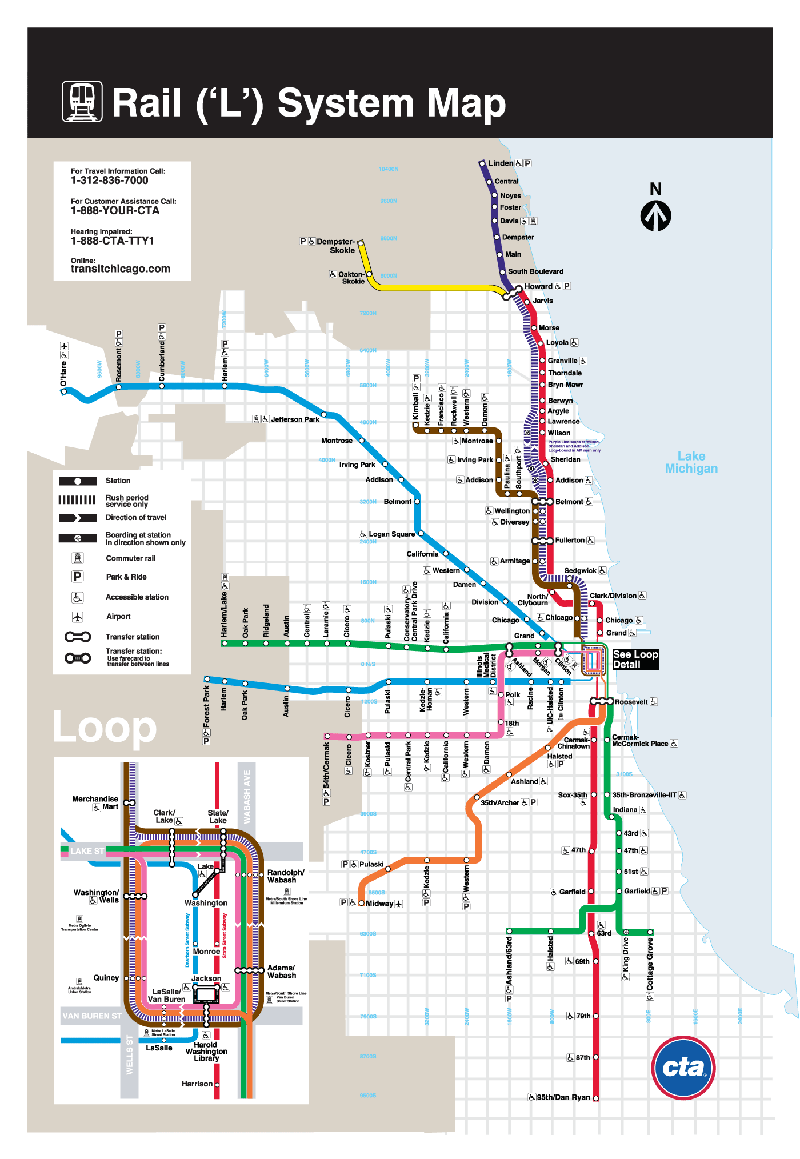The Chicago metro system, known as the Chicago “L” is operated by the Chicago Transit Authority. It has eight different lines that offer residents and visitors transportation throughout the city and to some surrounding suburbs.
The entire system is 165.4 km (102.8 mi) long and has 145 stations spread out along eight lines. The schedule varies each hour and a single ticket cost $3 (valid for 3 trips within 2 hours).
Metros in USA: Chicago L
Chicago’s rapid development at the end of the 19th century made it necessary to construct a much more efficient transportation system than the horses used in that era. Building an underground transportation system was too costly, so elevated rails were selected. In 1892, the precursor to the modern metro began to operate. At the time, it was just a steam locomotive that could transport a dozen people. These original rails still exists today as part of the green line.
Technological advances of the era generated enough income to build two additional lines. However, neither of these lines reached downtown due to regulations of the time that required a large number of permits in order to complete construction in that area. Thanks to Charles Tyson Yerkes, the necessary permits were obtained in 1897 and construction began on what we now know as the “loop”.
Since then, the system was expanded to join the existing lines with the “loop” and to construct lines that allowed Chicago residents and visitors to move easily throughout the city.
Lines and stations
The Chicago metro system has eight lines, 7 of which pass through a section of downtown known as the “loop”, which is a rectangle about the length of 3 kilometers (1.86 miles). This is the busiest section of Chicago’s metro system.
The entire system is 165.4 km (102.8 mi) in length and has 145 stations spread out along eight lines. In addition to offering transportation inside the city, Chicago’s metro also connects the surrounding suburbs. Each line has a route name and color, but it is the color that is used as a reference.
Red Line:
This line is Chicago metro’s busiest line. Its 33 stations are spread out along 37.7 kilometers (23.4 miles) that begin in the north at Howard station, pass through the underground section known as State Street and end at 95th/Dan Ryan station in Roseland in the south. Like the blue line, the red line operates 24 hours a day, every day of the year.
- Line color: Red
- Number of stations: 33
- Length: 37.7 kilometers (23.4 miles)
- Total trip duration: 65 minutes
- Schedule: This line operates 24 hours a day, every day of the week.
Stations: Howard, Jarvis, Morse, Loyola, Granville, Thorndale, Bryn Mawr, Berwyn, Argyle, Lawrence, Wilson, Sheridan, Addison, Belmont, Fullerton, North/Clybourn, Clark/Division, Chicago, Grand, Lake, Monroe, Jackson, Harrison, Roosevelt, Cermak-Chinatown, Sox-35th, 47th, Garfield, 63rd, 69th, 79th, 87th, 95th/Dan Ryan
Blue line:
The blue line extends from the O’Hare International Airport in the northeastern tip of the city. It passes through the “loop”, and ends in the far southeast at Forest Park station. It is the second busiest line, after the red line. It also runs 24 hours a day, every day of the year. This line has a station with the two repeating names. They are Harlem and Western which riders must especially pay attention to them in order to avoid confusion. The repeated names are distinguished depending on which section of the line one is located.
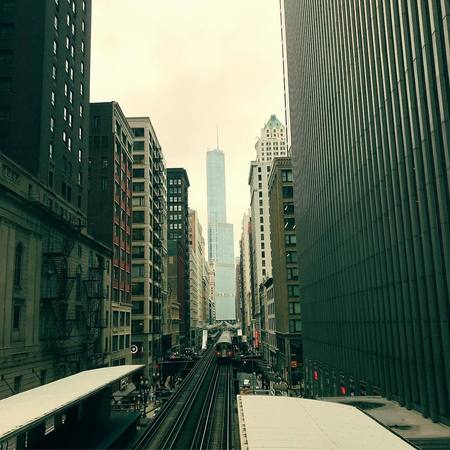 Chicago
Chicago
- Line color: Blue
- Number of stations: 33
- Length: 43.3 kilometers (27 miles)
- Total trip duration: 46 minutes
- Schedule: This line runs every day, 24 hours a day.
Stations: O’Hare, Rosemont, Cumberland, Harlem (O’Hare section), Jefferson Park, Montrose, Irving Park, Addison, Belmont, Logan Square, California, Western (O’Hare section), Damen, Division, Chicago, Grand, Clark/Lake, Washington, Monroe, Jackson, LaSalle, Clinton, UIC-Halsted, Racine, Illinois Medical District, Western (Forest Park section), Kedzie-Homan, Pulaski, Cicero, Austin, Oak Park, Harlem (Forest Park section), Forest Park
Brown Line:
This line has 27 stations spread out along 18 kilometers (11.18 miles). It begins and ends at Kimball station. After leaving Kimball station in the northeast part of the city, the line extends to the section known as the “loop, circling it counterclockwise, stopping at all the “loop” stations, and returning to Kimball following the same route.
- Line color: Brown
- Number of stations: 27
- Length: 18.3 kilometers (11.18 miles)
- Total trip duration: 43 minutes (from Kimball to Clark/Lake, the last station on the “loop”)
- Schedule: 4:00 am to 1:30 am Monday to Saturday and from 5:00 am a 1:30 am on Sundays.
Stations: Kimball, Kedzie, Francisco, Rockwell, Western, Damen, Montrose, Irving Park, Addison, Paulina, Southport, Belmont, Wellington, Diversey, Fullerton, Armitage, Sedgwick, Chicago, Merchandise Mart, Washington/Wells, Quincy, LaSalle/Van Buren, Harold Washington Library-State/Van Buren, Adams/Wabash, Washington/Wabash, State/Lake, Clark/Lake
Green Line:
The green line provides two different services that began in Harlem/Lake, pass through the “loop” and branch off after Garfield station to arrive at two different terminals: Ashland/63rd and Cottage Grove. It is the only line in the Chicago metro system that is completely elevated and also uses the oldest sections in the system.
- Line color: Green
- Number of stations: 30
- Length: 33.3 kilometers (20.7 miles)
- Total trip duration: 57 minutes to Cottage Grove and 61 minutes to/ Ashland/63rd
- Horario: Both routes run from 4:00 am to 1:00 am on weekdays and from 5:00 am to 1:00 am on weekends.
Stations: Harlem/Lake, Oak Park, Ridgeland, Austin, Central, Laramie, Cicero, Pulaski, Conservatory-Centrak Park Drive, Kedzie, California, Ashland, Morgan, Clinton, Clark/Lake, State/Lake, Washington/Wabash, Adams/Wabash, Roosevelt, Cermak-McCormick Place, 35th-Bronzeville-IIT, Indiana, 43rd, 47th, 51st, Garfield
Cottage Grove: King Drive, Cottage Grove
Ashland/63rd: Halsted, Ashland/63rd
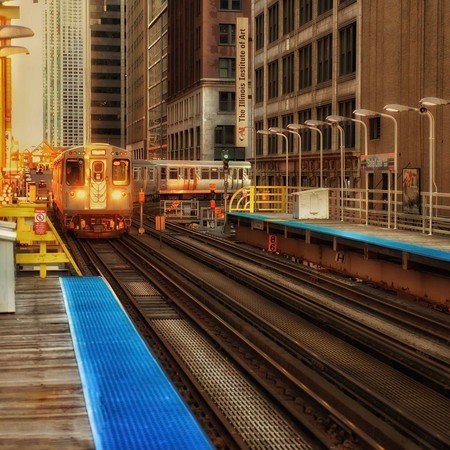
Orange Line:
This line’s 16 stations run from the Midway International Airport to the “loop”. Like the brown line, the orange line circulates around the “loop” and returns along the same route until it reaches Midway again.
- Line color: Orange
- Number of stations: 16
- Length: 20.1 kilometers (12.5 miles)
- Total trip duration: 33 minutes to Adams
- Schedule: 3:30 am to 1:25 am on weekdays and from 4:30 am to 1:25 am on the weekends.
Stations: Midway, Pulaski, Kedzie, Western, 35th/Archer, Ashland, Halsted, Roosevelt, Harold Washington Library-State/Van Buren, LaSalle/Van Buren, Quincy, Washington/Wells, Clark/Lake, State/Lake, Washington/Wabash, Adams/Wabash
Purple Line:
This line usually extends from Linden to Howard, passing through 9 stations but it has an additional express line that connects the Evanston and Wilmette suburbs with downtown Chicago. During peak hours (5:20 am to 10:15 am and 2:30 pm to 7:15 pm) the purple line extends from Howard to the final station on the “loop”.
- Line color: Purple
- Number of stations: 26 stations during peak time and 9 stations during non-peak hours
- Length: 24 kilometers (15 miles)
- Total trip duration: 12 minutes from Linden to Howard and 52 minutes from Linden to Washington/Wells
- Schedule: 4:25 am to 1:30 am from Monday to Thursday; 4:30 am to 2:10 am on Fridays; 5:05 am to 2:15 am on Saturdays and from 6:05 am to 1:45 am on Sundays.
Stations: Linden, Central, Noyes, Foster, Davis, Dempster, Main, South Blvd, Howard
During peak hours: Wilson, Belmont, Wellington, Diversey, Fullerton, Armitage, Sedgwick, Chicago, Merchandise Mart
Pink Line:
This is Chicago’s newest line with 22 stations connecting Cicero with downtown Chicago. Like the other lines, the pink line begins and ends at the same station. After leaving 54th/Cermak station, this line reaches the “loop” and after the Washington/Wells station, it returns along the same route.
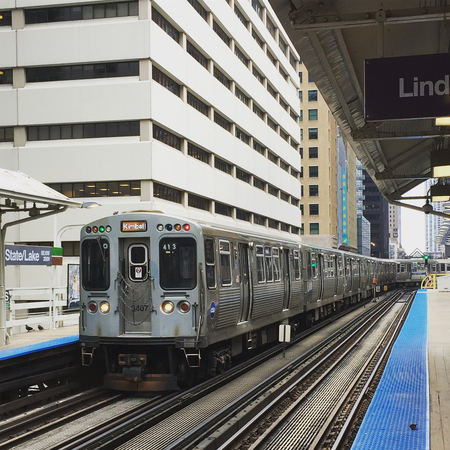 Chicago Loop
Chicago Loop
- Line color: Pink
- Number of stations: 22
- Length: 18 kilometers (11.2 miles)
- Total trip duration: 42 minutes to Washington/Wells station
- Schedule: 4:05 am to 1:25 am on weekdays and from 5:05 to 1:25 am on weekends.
Stations: 54th/Cermak, Cicero, Kostner, Pulaski, Central Park, Kedzie, California, Western, Damen, 18th, Polk, Ashland, Morgan , Clinton, Clark/Lake, State/Lake, Washington/Wabash, Adams/Wabash, Harold Washington Library/Van Buren, LaSalle/Van Buren, Quincy, Washington/Wells
Yellow Line:
The yellow line is the only line in Chicago’s metro system that doesn’t pass through the “loop”. Its three stations extend 8 kilometers (5 miles), beginning at Howard station in the north of Chicago, passing through Evanston and ending in Skokie.
- Line color: Yellow
- Number of stations: 3
- Length: 8.2 kilometers (5.1 miles)
- Total trip duration: 8 minutes
- Schedule: 4:45 am to 11:15 on weekdays and from 6:15 to 11:15 on weekends.
Stations: Dempster-Skokie, Oakton-Skokie, Howard
Schedules and frequency
Red Line and Blue Line:
As two of the few lines in the United States to operate continuously, the blue and red lines run 24 hours, every day of the year. On weekdays, they run every 2-7 minutes during peak hours and every 7-8 minutes during non-peak hours. On Saturdays, they run every 10 minutes during the morning, every 6-7 minutes during the day and every 6-8 minutes at night. On Sundays, the metros run every 10 minutes in the morning, every 6-9 minutes during the day and every 10 minutes at night.
Brown Line:
This line operates from 4:00 am to 1:30 am, Monday to Saturday and from 5:00 am to 1:30 am on Sundays. On weekdays, the metro runs every 3-8 minutes during peak hours, every 7-8 minutes during the day and every 6-12 minutes at night.
Green Line:
The two services on this line operate from 4:00 am to 1:00 am on weekdays and from 5:00 am to 1:00 am on weekends.
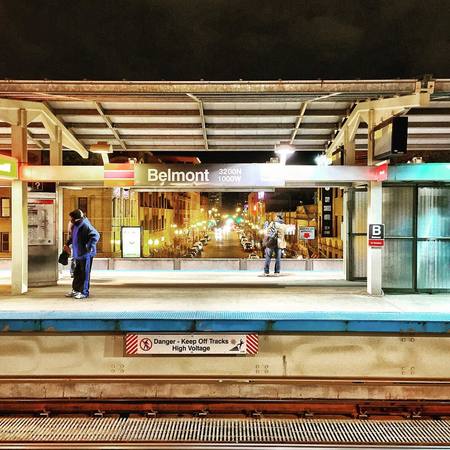 Chicago L
Chicago L
Orange Line:
This line operates from 3:30 am to 1:25 am on weekdays and from 4:30 am to 1:25 am on weekends.
Purple Line:
This line operates from 4:25 am to 1:30 am, Monday to Thursday; from 4:30 am to 2:10 am on Fridays; and from 5:05 am to 2:15 on Saturdays and from 6:05 am to 1:45 am on Sundays.
Yellow Line:
This line operates from 4:45 am to 11:15 pm on weekdays and from 6:15 am to 11:15 pm on weekends.
Connections
The connections between Chicago’s 8 metro lines are free and unlimited. The connections between the metro and buses cost $0.25 and allows two additional trips within 2 hours.
Connections from the red line to other lines:
- To the blue line: Lake, Jackson
- To the brown line: Belmont, Fullerton, Lake, Jackson
- To the green line: Lake, Roosevelt
- To the orange line: Lake, Jackson, Roosevelt
- To the purple line: Howard, Wilson, Belmont, Fullerton, Lake, Jackson
- To the pink line: Lake, Jackson
- To the yellow line: Howard
Connections from the blue line to other lines:
- To the red line: Washington, Jackson
- To the brown line: Clark/Lake, Jackson
- To the green line: Clark/Lake
- To the orange line: Clark/Lake, Jackson
- To the purple line: Clark/Lake, Jackson
- To the pink line: Clark/Lake, Jackson
- To the yellow line: No connection/
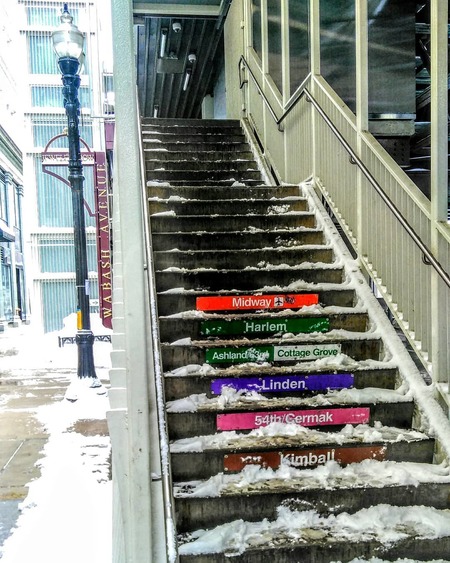 Chicago Metro
Chicago Metro
Connections from the brown line to other lines:
- To the red line: Belmont, Fullerton, Harold Washington Library-State/Van Buren, State/Lake
- To the blue line: Harold Washington Library-State/Van Buren, Clark/Lake
- To the green line: Adams/Wabash, Clark/Lake
- To the orange line: Washington/Wells, Harold Washington Library-State/Van Buren, Adams/Wabash
- To the purple line: Belmont, Fullerton, Merchandise Mart, Washington/Wells, Harold Washington Library-State/Van Buren, Adams/Wabash, Clark/Lake
- To the pink line: Washington/Wells, Harold Washington Library-State/Van Buren, Adams/Wabash, Clark/Lake
- To the yellow line: No connections
Connections from the green line to other lines:
- To the red line: State/Lake, Roosevelt
- To the blue line: Clark/Lake
- To the brown line: Clark/Lake, Adams/Wabash
- To the orange line: Clark/Lake, Adams/Wabash, Roosevelt
- To the purple line: Clark/Lake and Adams/Wabash
- To the pink line: Ashland, Clinton, Clark/Lake, Adams/Wabash
- To the yellow line: No connections
Connections from the orange line to other lines:
- To the red line: Roosevelt, Harold Washington Library-State/Van Buren. State/Lake
- To the blue line: Harold Washington Library-State/Van Buren. Clark/Lake
- To the brown line: Harold Washington Library-State/Van Buren, Washington/Wells, Clark/Lake, Adams/Wabash
- To the green line: Roosevelt, Clark/Lake, Adams/Wabash
- To the purple line: Harold Washington Library-State/Van Buren, Washington/Wells, Clark/Lake, Adams/Wabash
- To the pink line: Harold Washington Library-State/Van Buren, Washington/Wells, Clark/Lake, Adams/Wabash
- To the yellow line: No connections
Connections from the purple line to other lines:
- To the red line: Howard, Wilson, Belmont, Fullerton, State/Lake, Harold Washington Library-State/Van Buren
- To the blue line: Clark/Lake, Harold Washington Library-State/Van Buren
- To the brown line: Belmont, Fullerton, Merchandise Mart, Clark/Lake, Adams/Wabash, Harold Washington Library-State/Van Buren, Washington/Wells
- To the green line: Clark/Lake, Adams/Wabash,
- To the orange line: Clark/Lake, Adams/Wabash, Harold Washington Library-State/Van Buren, Washington/Wells
- To the pink line: Clark/Lake, Adams/Wabash, Harold Washington Library-State/Van Buren, Washington/Wells
- To the yellow line: Howard
Conexiones entre la línea café y otras líneas:
- Con la línea roja: Belmont, Fullerton, Harold Washington Library-State/Van Buren, State/Lake
- Con la línea azul: Harold Washington Library-State/Van Buren, Clark/Lake
- Con la línea verde: Adams/Wabash, Clark/Lake
- Con la línea naranja: Washington/Wells, Harold Washington Library-State/Van Buren, Adams/Wabash
- Con la línea morada: Belmont, Fullerton, Merchandise Mart, Washington/Wells, Harold Washington Library-State/Van Buren, Adams/Wabash, Clark/Lake
- Con la línea rosada: Washington/Wells, Harold Washington Library-State/Van Buren, Adams/Wabash, Clark/Lake
- Con la línea amarilla: No hay conexiones
Conexiones entre la línea verde y otras líneas:
- Con la línea roja: State/Lake, Roosevelt
- Con la línea azul: Clark/Lake
- Con la línea café: Clark/Lake, Adams/Wabash
- To the red line: State/Lake, Harold Washington Library-State/Van Buren
- To the blue line: Clark/Lake, Harold Washington Library-State/Van Buren
- To the brown line: Clark/Lake, Adams/Wabash, Harold Washington Library-State/Van Buren, Washington/Wells
- To the green line: Ashland, Clinton, Clark/Lake, Adams/Wabash
- To the orange line: Clark/Lake, Adams/Wabash, Harold Washington Library-State/Van Buren, Washington/Wells
- To the purple line: Clark/Lake, Adams/Wabash, Washington/Wells
- To the yellow line: No connection
- To the red line: Howard
- To the purple line: Howard
- Metro ticket: $2.50
- Bus ticket: $2.25
- Transfer: $0.25 (2 additional trips within 2 hours)
- Unlimited day pass: $10
- Unlimited 3 day pass: $20
- Unlimited 7 day pass: $28
- Unlimited 30 day pass: $105
- Single ticket: $3 (valid for three trips within two hours)
- Single ticket from the airport: $5 (valid for three trips within two hours)
- Unlimited 1 day pass: $10
- Unlimited 3 day pass: $20
- On some lines, such as the blue line, you will find two stations with the same name. Consult the map thoroughly before leaving to make sure you are exiting and heading to the proper stations.
- With the exception of the yellow line, all lines pass through the “loop”, which is a great place to make connections between lines.
- The red line and the blue line operate 24 hours, but this doesn’t indicate that riders are always present. The stations are deserted and can be dangerous late at night and during the early morning hours.
- The Chicago metro system is the fourth largest one in the United States with a total length of 165 kilometers (102.5 miles)
- In addition to being the fourth largest metro system, it is also the second busiest metro system in the United States, after the City of New York.
- The red line and the blue line operate 24 hours a day, every day of the year, making the Chicago metro one of only six metro systems in the United States that provide 24 hour service.
- The oldest sections on Chicago’s metro began operating in 1892, making it America’s second oldest metro system, after the elevated metro sections of the City of New York.
- Riders often refer to the Chicago metro as the Chicago “L”, a nickname that it received due to the elevated part of the system.
- The intersection at Lake and Wells in the section known as the “loop” was recorded in the Guinness Book of World Records as the busiest intersection in the world.
- Midway International Airport: The orange line takes riders directly to this airport.
- O’Hare International Airport: The blue line takes riders directly to this airport.
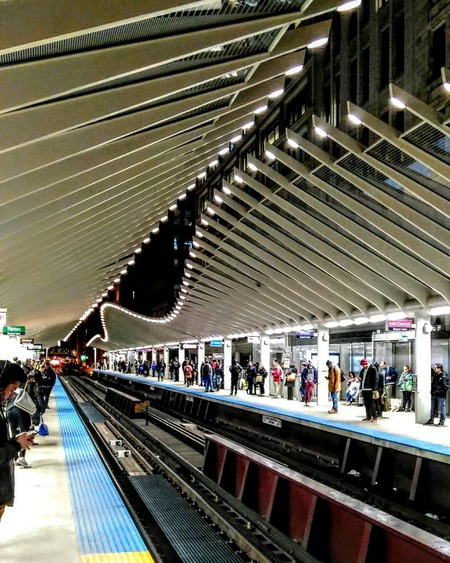 Chicago metropolitan area
Chicago metropolitan area
Connections from the pink line to other lines:
Connections from the yellow line to other lines:
Prices, tickets and passes
Ventra Card:
This is a reloadable plastic card that can be loaded with money for a metro or bus ride or that can be used to purchase any of the available passes. It cost $5 and can be purchased and reloaded on any station machine, via the online app or at any of the locations throughout the city.
Ventra card fares: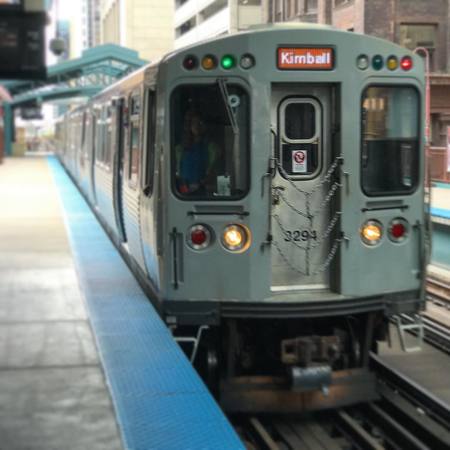 chicago Metro
chicago Metro
Single tickets:
If you do not wish to use the Ventra card you can purchase single tickets from the machines located at each station.
Rules, tips and warnings
Notable facts
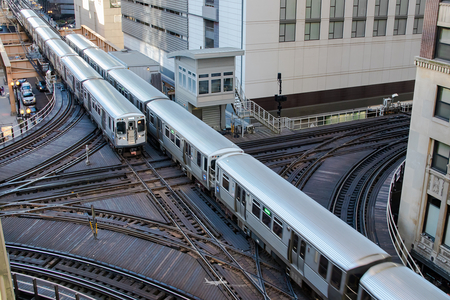 chicago Metro
chicago Metro
Future expansions
One of the largest projects to be carried out is the maintenance, modernization and extension of the red line, which is the system’s busiest line. In addition to modernizing some of the red line stations, the project also includes an extension from its current terminal at 95th/Dan Ryan to 130th Street.
Additionally, work on the blue line to modernize the stations and eliminate the low speed zones along its path are currently being completed. It is expected that this project will reduce the trip duration between the O’Hare airport and downtown by up to 10 minutes.
Connections to the airport
Chicago has two airports: the Midway International Airport and the O’Hare International Airport which was deemed the world’s busiest airport. The Chicago metro provides direct connections to both airports:
 Chicago
Chicago
Sightseeing via metro
Willis Tower: This 442 meter (1450 foot), 110 floor skyscraper was once the tallest building in the world. Today, its balconies that are known as skyboxes, have glass bottoms that are great for enjoying the city views. The brown, orange, pink and purple line take you to Quincy/Wells station which is five minutes from the tower.
Millennium Park: This is one of the city’s most visited sites and the location of many concerts and exhibitions. Its famous sculpture, the Bean, is one of Chicago’s icons and can be found just a few steps from the Art Institute. Five lines take you to the Washington/Wabash station which is just a few minutes from the park.
Metro map of Chicago
Map via www.transitchicago.comSee map full resolution. It may take a little bit to load.
Chicago L map
- Also Known As: L
- Passengers/Day 542000
- Fares: 1.58
- 24h operation: Every night: Red and Blue lines
- Air Conditioning: Yes
- Walk between platforms: No
- Driverless trains: No
- Screen Doors Platforms: No
- Operator: Chicago Transit Authority (CTA)
- $2.25
- Chicago Metro Official Website
- Tlf: +1 888 968 7282
Help us
If you consider that the information we provide is wrong, not accurated, outdated, translation contains errors, and you would like to help us to improve the file...you can contact us here.
Feel free to contact us if you dont find the system you're looking for and we'll add it as soon as we can!
Thank you very much!








